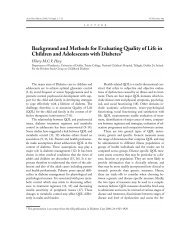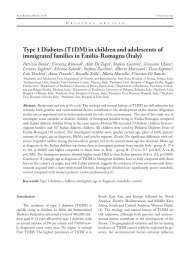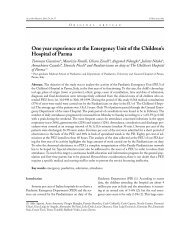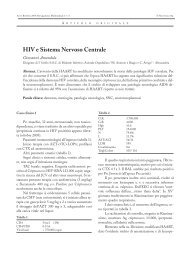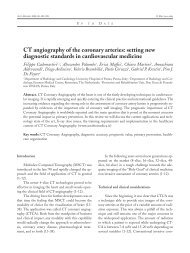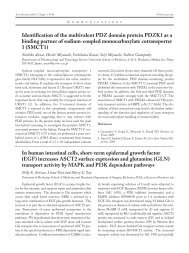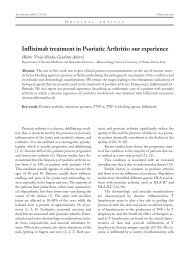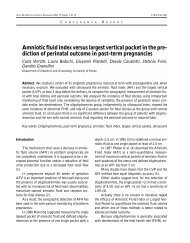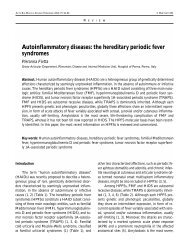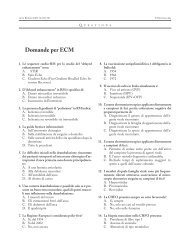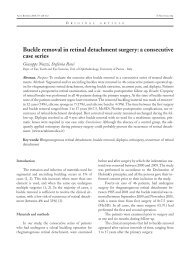Short reports+frontesp96-98 - Acta Bio Medica Atenei Parmensis
Short reports+frontesp96-98 - Acta Bio Medica Atenei Parmensis
Short reports+frontesp96-98 - Acta Bio Medica Atenei Parmensis
Create successful ePaper yourself
Turn your PDF publications into a flip-book with our unique Google optimized e-Paper software.
<strong>Short</strong> Reports<br />
111<br />
Aims: Surgery is the mainstay of treatment for<br />
patients with periampullary tumors. We report survival<br />
and recurrence data in patients undergoing palliative<br />
or curative surgery for these tumors, evaluating<br />
prognostic factors that could affect survival and disease-free<br />
survival in the subgroup of patients who underwent<br />
resection. Methods: Survival and disease free<br />
survival were evaluated in 140 patients who presented<br />
with periampullary tumors. Univariate and multivariate<br />
analyses were performed on several clinicopathologic<br />
variables to determine factors affecting survival<br />
and recurrence in the subset of patients treated by resection.<br />
Results: The overall median survival time was<br />
6 months after by-pass operations and 17 months after<br />
resection. The 1-, 3- and 5 year actuarial survival<br />
rates after resection were 62.5, 19.6 and 14.2% respectively.<br />
The 1-, 3- and 5 year disease-free survival rates<br />
after resection were 40.1%, 14.2% and 9.8%. Multivariate<br />
analysis identified only a pre-operative bylirubin<br />
level over 200 µmol/L (p=0.02) as a significant predictor<br />
of poor prognosis in patients with pancreatic<br />
adenocarcinoma. Tumor differentiation (p=0.01) and<br />
tumor staging (p=0.02) had an indipendent significant<br />
relationship to disease-free survival in patients with<br />
pancreatic adenocarcinoma, whereas age over 70 years<br />
(p=0.04) and lymphatic invasion (p=0.01) were found<br />
to be significantly related to disease-free survival in<br />
patients with non pancreatic periampullary adenocarcinoma.<br />
Conclusions: Several parameters were found<br />
to have an impact on survival and disease-free survival<br />
after resection for periampullary tumors. Further investigations<br />
are mandatory to clarify the link between<br />
these factors and early recurrence in light of a generally<br />
dismal prognosis of these tumors.<br />
The outcome of laparoscopic colorectal surgery<br />
in elderly patients: our experience<br />
R. Lionetti, C. Saviano, R. Brunaccino, M. D’Ambra, D.<br />
Fico, A.A. Jamshidi, M. Rutigliano, D. Pelaggi, S. Simioli,<br />
S. Dilillo, G.P. Ferulano<br />
AOC Policlinico “Federico II”, Naples, Italy<br />
The increasing proportion of the population aged<br />
over 65 has pushed surgeons to find better strategies<br />
of treatments in elderly patients, also considering the<br />
high prevalence of co-morbid conditions. Miniinvasive<br />
surgery may have a big impact on these patients,<br />
although it has not yet been universally accepted.<br />
Considering that the incidence of both benign and<br />
malignant colo-rectal disease is proportional to age,<br />
we retrospectively review our series of laparoscopic colorectal<br />
resection (LCR) in patients ≥ 65 years of age<br />
investigating the incidence of short-term complications<br />
and mortality due to the surgical procedure and<br />
presence of co-morbidity. Methods: From January<br />
2000 to April 2005 52 patients aged 65 and above<br />
(65-82, mean age 69 yrs) underwent LCR. Diagnoses<br />
were 21 diverticulitis and 31 colo-rectal cancer Dukes<br />
T1-T2-T3. Procedures performed were right hemicolectomy<br />
(3), left hemicolectomy (5), anterior resection<br />
(29), sigmoid resection (8), Hartmann’s procedure (3),<br />
abdominoperineal resection (4). Fortysix patients<br />
(88%) had at least one co-morbidity (Tab. 1), 11 of 52<br />
were classified as ASA II, 37 ASA III, 4 ASA IV. Results:<br />
Conversion to open surgery was necessary in 3<br />
cases due to underestimated disease (tumor mass, fixation<br />
etc.) 3 for technical error due to learning curve<br />
and 1 for endoluminal stappler defect (total 14%).<br />
Duration of surgery was 220 min (± 40 min); the<br />
length, depending on the type of procedure, has however<br />
decreased with experience.. Less bleeding has been<br />
noticed during mesorectal excision in 7 patients who<br />
underwent neo-adjuvant chemo-therapy. There were<br />
no perioperative deaths and no laparoscopic related<br />
morbidity. Postoperative complications occurred in 11<br />
patients (21%), 7 ASA III and 4 ASA IV (Tab. 2)<br />
which compares favourably with results of open colectomy<br />
in ours and other published series. In particular<br />
the incidence of pulmonary complications and wound<br />
infections is clearly lower. A median hospitalisation in<br />
no complicated patients was 9 days which is significantly<br />
shorter when compared to many series of open<br />
colectomies. Conclusions: The results of our short ex-<br />
Table 1. Co-morbidities<br />
Co-morbidities No patients (%)<br />
Hypertension 39 (75%)<br />
Chronic Obstructive Pulmonary Disease 28 (53%)<br />
Diabetes Mellitus 19 (36%)<br />
Ischemic Heart Disease 9 (17%)<br />
Others 32 (61%)



